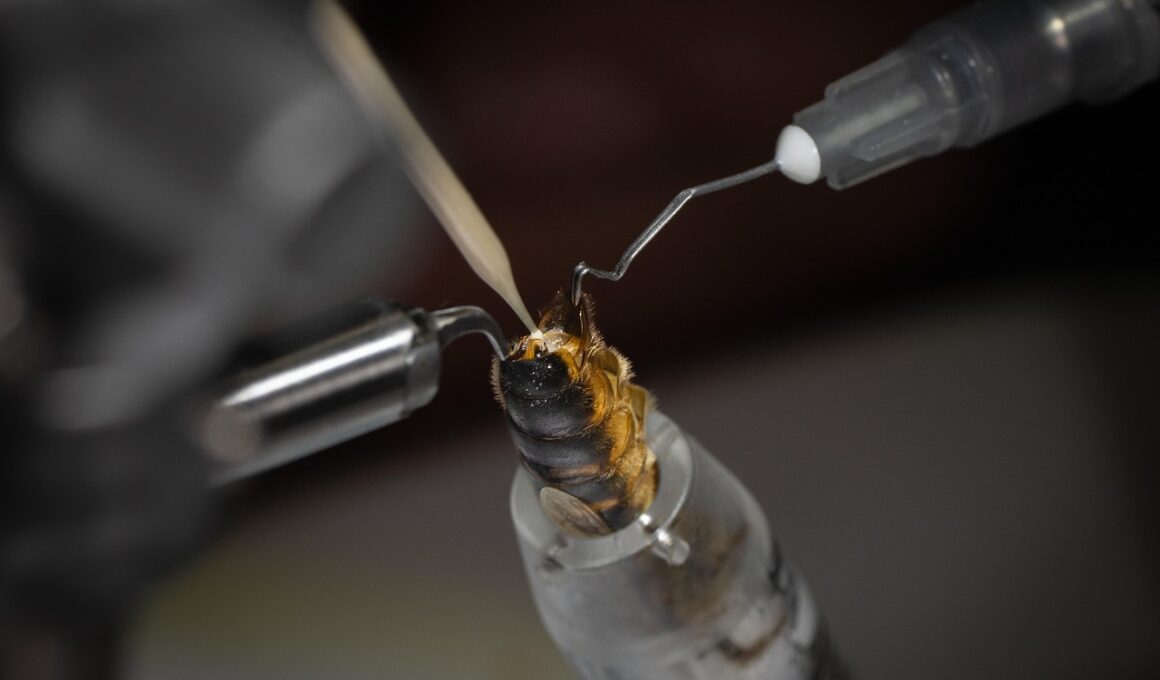Artificial Insemination in Dogs: Best Practices and Protocols
Artificial insemination (AI) is a breakthrough technique used in dog breeding that can enhance the breeding process significantly. Breeders utilize this method to ensure improved genetic diversity and to facilitate the breeding of dogs that are geographically separated. AI can be particularly advantageous for breeds that have fertility challenges or specific health issues. Proper knowledge and understanding of the AI process are crucial for breeders looking to optimize their breeding practices. It is also essential for breeders to assess factors such as timing and the dog’s reproductive status for the best results. Before beginning the insemination process, it is advisable to consult with a veterinarian to ensure the dog’s health is suitable. The procedure typically involves collecting semen from the male followed by inseminating the female at the right point in her estrous cycle. Success rates can be high when appropriate protocols and equipment are utilized effectively. Maintaining accurate records of heat cycles, breeding dates, and health screenings can also support successful outcomes in artificial insemination.
In addition to improving genetic diversity, artificial insemination brings numerous advantages for dog breeders. It allows for the use of frozen or shipped semen, which can expand breeding options significantly. To maximize the chances of successful insemination, techniques and tools must be applied correctly. Various methods of insemination include transcervical insemination, surgical insemination, and intrauterine insemination. Each technique has its specific applications and requires particular skills, tools, and knowledge of reproductive anatomy and physiology. Training and experience in using these techniques help ensure successful mating and pregnancy in the female dog. Factors such as semen quality and insemination timing can influence the outcomes significantly. Selecting the ideal breeding time using hormonal testing or physical observations helps attain a higher pregnancy rate. Proper storage and handling of semen are also critical, ensuring it retains viability throughout its journey. Veterinary professionals can provide valuable guidance throughout the process, enhancing the breeding program’s effectiveness and efficiency, leading to healthy, genetically valuable litters. The use of AI calls for a collaborative effort between experienced breeders and qualified veterinarians, facilitating successful breeding outcomes.
Key Steps in the Artificial Insemination Process
The artificial insemination process consists of several key steps that require precision and expertise. Start by ensuring that both the male and female dogs are in optimal health. A thorough veterinary examination reveals the breeding suitability of both dogs, including screenings for any genetic disorders. Once confirmed, the next step is to monitor the female’s estrous cycle closely. This can be done through behavioral signs, hormonal testing, or vaginal cytology. Proper timing is vital as it influences the chances of a successful conception. Following this, collect the semen from the male dog using appropriate techniques. Semen can be processed in various forms, including fresh, cooled, or frozen. Each type has specific handling and storage procedures, ensuring that the sperm remains viable. After preparing the semen, it can be introduced into the female’s reproductive tract. It’s crucial to select the right insemination method that corresponds with the collected semen type. Be aware of all relevant protocols and practices to take full advantage of this powerful breeding tool and maximize the chances of successful mating.
Post-insemination care is another critical aspect of artificial insemination that is often overlooked. After completing the insemination procedure, it is important to monitor the female dog for any signs of discomfort or complications. A calm and stress-free environment can aid in the process of conception, so ensure the female is relaxed following the procedure. Supportive care, including proper nutrition and hydration, enhances her overall health. A veterinary follow-up is recommended approximately 30 days after insemination to conduct a pregnancy examination. This can involve ultrasound or blood tests to confirm whether the female successfully conceived. If pregnancy occurs, continued veterinary care during gestation is essential, including vaccinations and health monitoring. Additionally, breeders should keep records of the insemination method, semen type, and health checks for future reference. This information can guide future breeding decisions and refine practices. Keeping excellent records protects both the breeder’s interests and the dogs involved. Continuous education about reproductive health is vital for each step of the breeding program, leading to better outcomes for all parties involved.
Pitfalls to Avoid in Artificial Insemination
Despite its numerous benefits, artificial insemination does come with certain pitfalls that breeders must be aware of to ensure success. One common mistake is underestimating the importance of timing in the breeding process. Inseminating too early or too late can diminish the chances of conception. Breeders should use scientific methods for tracking the female’s heat cycle accurately and should not rely solely on behavioral signs. Another pitfall includes poor semen handling, which may lead to decreased sperm viability. Following established protocols for semen collection, storage, and transportation is critical. Additionally, failure to seek veterinary guidance can result in complications that could have been avoided. A veterinarian’s expertise ensures that an appropriate breeding strategy is employed, taking into account the dogs’ health and reproductive cycles. Neglecting prenatal care can also lead to issues during pregnancy or complications at birth. Education, collaboration, and attentiveness at each step in the process can mitigate these pitfalls. Breeders practicing artificial insemination must continuously strive for knowledge and improvement, ensuring a successful breeding experience.
Another challenge in artificial insemination is ensuring the quality of the semen used. Poor-quality semen can significantly reduce the chances of a successful pregnancy. It is essential to confirm not only viability but also motility and concentration before proceeding with insemination. Breeders should work closely with reputable veterinarians or insemination specialists to ensure high-quality semen is being utilized. Additionally, maintaining the right conditions for semen storage and transport is important to ensure its viability. When using frozen semen, the breeding facility must have adequate resources and expertise to handle it correctly. Another common issue is managing inbreeding risks associated with using AI. Even though AI allows for wider geographic reach, it can inadvertently narrow genetic diversity if not managed correctly. Thus, breeders should remain vigilant about genetic testing and maintain thorough pedigree records to avoid inbreeding. Employing a sensible and responsible breeding strategy can help navigate these challenges. Continually refining techniques, tools, and methodologies alongside guidance from veterinary experts can lead to a sustainable and successful artificial insemination practice.
The Future of Artificial Insemination in Dogs
The landscape of artificial insemination in dogs continues to evolve with advancements in technology and reproductive science. Innovative techniques, such as intracytoplasmic sperm injection and pre-implantation genetic diagnosis, have begun to show promise in enhancing breeding success and ensuring healthy puppies. These techniques allow for even greater precision in the selection of genetics, addressing hereditary diseases more effectively. Moreover, as genetic testing capabilities improve, breeders have the opportunity to make informed decisions, ensuring that they are promoting the health and longevity of future generations. Implementing more sophisticated tracking systems for breeding and health records will also enhance the overall effectiveness of artificial insemination practices. The increasing collaboration within the veterinary community will foster further advancements, providing the most current knowledge and practical applications to breeders. As society becomes more aware of responsible breeding, ethical considerations will guide breeders towards healthier breeding practices. Consequently, the demand for sustainable and scientifically backed breeding methods continues to rise, ultimately benefiting the overall well-being of dog breeds. The future of artificial insemination looks promising as techniques integrate with innovative practices aimed at advancing responsible dog breeding.
In conclusion, artificial insemination in dogs represents a remarkable opportunity for breeders to enhance their breeding practices. By understanding the key methods, challenges, and future prospects of AI, breeders can refine their processes to achieve better outcomes. Attention to detail, collaboration with veterinary professionals, and a commitment to ongoing education will pave the way for successful breeding experiences. Practicing responsible breeding techniques through artificial insemination ensures the health and welfare of both the puppies and their parent dogs. Improved genetic diversity and mitigation of inherited diseases will ultimately yield healthier canine companions. Moreover, as new technology and research emerge, breeders can stay ahead of the curve, implementing best practices that align with ethical and sustainable breeding standards. Emphasizing successful post-insemination care, veterinarian involvement, and record-keeping all contribute to a holistic approach. The conscientious use of artificial insemination not only changes the face of dog breeding but also holds the potential to improve dog health in broader terms. Those involved in dog breeding have a duty to stay informed and proactive, championing the responsible use of artificial insemination in their breeding strategies.


